Remove the main bearing caps (A).
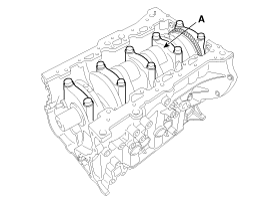
Use fender covers to avoid damaging painted surfaces.
To avoid damaging the cylinder head, wait until the engine coolant temperature drops below normal temperature (20°C [68°F]) before removing it.
When handling a metal gasket, take care not to fold the gasket or damage the contact surface of the gasket.
To avoid damage, unplug the wiring connectors carefully while holding the connector portion.
Mark all wiring and hoses to avoid misconnection.
Turn the crankshaft damper pulley so that the piston of No. 1 cylinder is at TDC (top dead center) on compression stroke.
Remove the engine and transaxle assembly.
(Refer to Engine And Transaxle Assembly - "Engine And Transaxle Assembly")
Remove the transaxle assembly from the engine assembly.
Manual Transaxle : (Refer to Manual Transaxle System - "Manual Transaxle")
Automatic Transaxle : (Refer to Automatic Transaxle System - "Automatic Transaxle")
Manual Transaxle : Remove the flywheel.
(Refer to Cylinder Block - "Flywheel")
Automatic Transaxle : Remove the drive plate.
(Refer to Cylinder Block - "Drive Plate")
Remove the encoder and the rear oil seal case assembly.
(Refer to Cylinder Block - "Rear Oil Seal")
Install the engine assembly to engine stand for disassembly.
Remove the intake manifold.
(Refer to Intake And Exhaust System - "Intake Manifold")
Remove the EGR & thermostat housing assembly.
(Refer to Cooling System - "Water Temperature Control Assembly")
Remove the exhaust manifold.
(Refer to Intake And Exhaust System - "Exhaust Manifold")
Remove the lower oil pan and upper oil pan.
(Refer to Lubrication System - "Oil Pan")
Remove the balance shaft & oil pump module.
(Refer to Lubrication System - "Balance Shaft & Oil Pump")
Remove the timing chain.
(Refer to Timing System - "Timing Chain")
Remove the cylinder head.
(Refer to Cylinder Head Assembly - "Cylinder Head")
Remove the high pressure fuel pump.
(Refer to Engine Control/Fuel System - "High Pressure Pump")
Remove the water pump assembly.
(Refer to Cooling System - "Water Pump")
Remove the piston and connecting rod assemblies.
(Refer to Cylinder Block - "Piston and Connecting Rod")
Check the main bearing oil clearance.
Remove the main bearing caps (A).

Check the crankshaft end play.
Lift the crankshaft (A) out of the cylinder block, being careful not to damage journals.
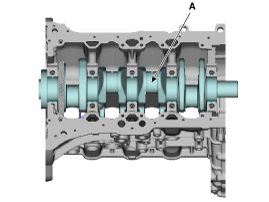
Arrange the main bearings and thrust bearings in the correct order.
Keep the main bearing caps with their bearings assembled together.
Check the crankshaft main bearing oil clearance.
To check main bearing-to-journal oil clearance, remove the bearing caps with their lower bearings.
Clean each main journal and lower bearing with a clean shop towel.
Place one strip of plastigage across each main journal.
Reinstall the bearing caps with their lower bearings, then tighten the bolts.
Tightening torque :
49.0 N.m (5.0 kgf.m, 36.2 lb-ft) + 120°
Do not turn the crankshaft.
Do not reuse the main bearing cap bolts.
Remove the bearing caps with their lower bearing again, and measure the widest part of the plastigage.
Bearing oil clearance :
0.026 ~ 0.044 mm (0.0010 ~ 0.0017 in)
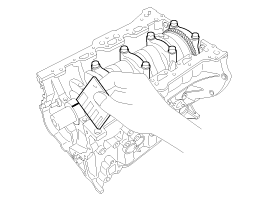
If the plastigage measures too wide or too narrow, remove the upper and lower bearing and then install a new bearings with the same color mark. Recheck the oil clearance.
Do not file, shim, or scrape the bearings or the cap to adjust clearance.
If the plastigage shows the clearance is still incorrect, try the next larger or smaller bearing. Recheck the oil clearance.
If the proper clearance cannot be obtained by using the appropriate larger or smaller bearings, replace the crankshaft and start over.
If the marks are indecipherable because of an accumulation of dirt and dust, do not scrub them with a wire brush or scraper. Clean them only with solvent or detergent.
Select the bearing by using selection table.
Letters have been stamped on the side of block as a mark for the size of each of the 5 main journal bores.
Use them, and the numbers or letters stamped on the crank (marks for main journal size), to choose the correct bearings.
Crankshaft main bearing | Cylinder block crankshaft journal bore mark | |||
A(A) | B(B) | C(C) | ||
Crankshaft main journal mark | I(A) | A(Blue) | B(Black) | C(Red) |
II(B) | B(Black) | C(Red) | D(Green) | |
III(C) | C(Red) | D(Green) | E(Yelllow) | |
Class | Mark | Cylinder block journal bore inner diameter |
A | A | 64.000 ~ 64.006 mm (2.5197 ~ 2.5199 in) |
B | B | 64.006 ~ 64.012 mm (2.5199 ~ 2.5202 in) |
C | C | 64.012 ~ 64.018 mm (2.5202 ~ 2.5204 in) |
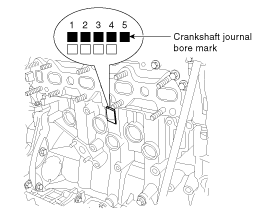
Class | Mark | Crankshaft main journal outer diameter |
I | A | 60.012 ~ 60.018 mm (2.3627 ~ 2.3629 in) |
II | B | 60.006 ~ 60.012 mm (2.3624 ~ 2.3627 in) |
III | C | 60.000 ~ 60.006 mm (2.3622 ~ 2.3624 in) |
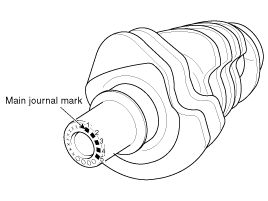
Class | Color | Crankshaft main bearing thickness |
A | Blue | 1.975 ~ 1.978 mm (0.0778 ~ 0.0779 in) |
B | Black | 1.978 ~ 1.981 mm (0.0779 ~ 0.0780 in) |
C | Red | 1.981 ~ 1.984 mm (0.0780 ~ 0.0781 in) |
D | Green | 1.984 ~ 1.987 mm (0.0781 ~ 0.0782 in) |
E | Yellow | 1.987 ~ 1.990 mm (0.0782 ~ 0.0783 in) |
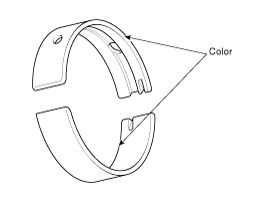
Check the crankshaft end play.
Using a dial indicator, measure the thrust clearance while prying the crankshaft back and forth with a screwdriver.
Crankshaft end play.
0.07 ~ 0.25 mm (0.0028 ~ 0.098 in)
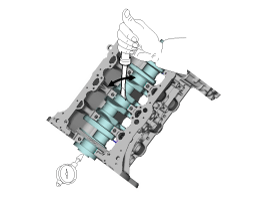
If the end play is greater than specification, replace the thrust bearings as a set.
Thickness of thrust bearing :
1.925 ~ 1.965 mm (0.0758 ~ 0.0774 in)
Inspect the crankshaft main journals and pin journals.
Using a micrometer, measure the diameter of each main journal and pin journal.
Main journal diameter :
60.000 ~ 60.018 mm (2.3622 ~ 2.3629 in)
Pin journal diameter
2.0L : 48.000 ~ 48.018 mm (1.8898 ~ 1.8905 in)
2.2L : 52.000 ~ 52.018 mm (2.0472 ~ 2.0479 in)
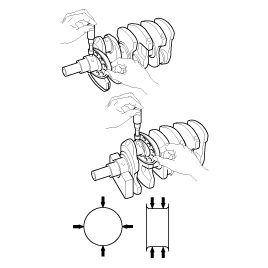
Thoroughly clean all parts to assembled.
Before installing the parts, apply fresh engine oil to all sliding and rotating surfaces.
Install the crankshaft main bearings.
Upper bearings have an oil groove of oil holes ; Lower bearings do not.
Align the bearing claw with the claw groove of the cylinder block, and push in the 5 upper bearings (A).
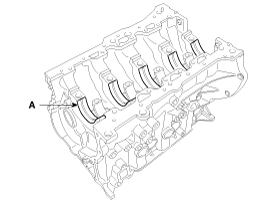
Align the bearing claw with the claw groove of the main bearing cap (B), and push in the 5 lower bearings (A).

Apply a coat of engine oil after assembling the main bearings.
Install the thrust bearings (No.4 journal).
Install the 2 thrust bearings (B) on both sides of the No.4 journal of the cylinder block with the oil groove (A) facing out.
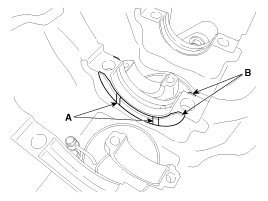
Place the crankshaft (A) on the cylinder block.
Apply a coat of engine oil to the pin and main journals after assembling the crankshaft.
Install the main bearing caps (B) and tighten the cap bolts.
Do not reuse the bearing cap bolts.
Be sure to assemble the main bearing caps in correct order.
Install the main bearing cap with the arrow facing the front of the engine.
Tighten all the main bearing cap bolts with the specified torque first, and then retighten all the bolts with the specified angle.
Apply a light coat of engine oil on the threads of the bolts. Tighten all the bolts with the specified torque in numerical order first, then tighten all the bolts with the specified angle in numerical order.
Tightening torque :
49.0 N.m (5.0 kgf.m, 36.2 lb-ft) + 120°
Using the SST (09221-4A000) (C), tighten the main bearing cap bolts.
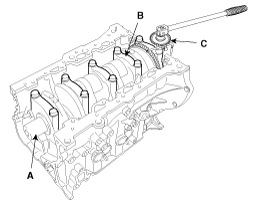
Check that the crankshaft turns smoothly.
Check the crankshaft end play.
Assemble the other parts in the reverse order of disassembly.
In case the crankshaft is replaced with a new one, select the proper connecting rod bearing according to the pin journal mark on the crankshaft.
Connecting rod bearing selection
(Refer to Cylinder Block - "Piston and Connecting Rod")